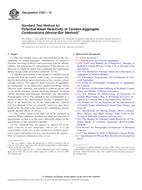Potřebujeme váš souhlas k využití jednotlivých dat, aby se vám mimo jiné mohly ukazovat informace týkající se vašich zájmů. Souhlas udělíte kliknutím na tlačítko „OK“.
ASTM C227-10
Standard Test Method for Potential Alkali Reactivity of Cement-Aggregate Combinations (Mortar-Bar Method) (Withdrawn 2018)
Automaticky přeložený název:
Standardní zkušební metoda pro potenciální alkalickém reaktivita Cement kameniva kombinace (malty Bar metoda)
NORMA vydána dne 1.2.2010
Informace o normě:
Označení normy: ASTM C227-10
Poznámka: NEPLATNÁ
Datum vydání normy: 1.2.2010
Kód zboží: NS-12636
Počet stran: 6
Přibližná hmotnost: 18 g (0.04 liber)
Země: Americká technická norma
Kategorie: Technické normy ASTM
Kategorie - podobné normy:
Anotace textu normy ASTM C227-10 :
Keywords:
aggregate, alkali-silica reaction, cement, length change, mortar, Aggregate (potential alkali reactivity), Cement-aggregate combinations, Change in length, Mortar bars, Volumetric measurement--cement/concrete, ICS Number Code 91.100.10 (Cement. Gypsum. Lime. Mortar)
Doplňující informace
| Significance and Use | ||||||||||||||||||||||||||
|
Data correlating the results of tests performed using this test method with performance of cement-aggregate combinations in concrete in service, results of petrographic examination of aggregates (Guide C295), and results of tests for potential reactivity of aggregates by chemical methods have been published in Test Method C289 and should be consulted in connection with the use of results of tests performed using this test method as the basis for conclusions and recommendations concerning the use of cement-aggregate combinations in concrete. The results of tests performed using this method furnish information on the likelihood that a cement-aggregate combination is potentially capable of harmful alkali-silica reactivity with consequent deleterious expansion of concrete. Criteria to determine potential deleterious alkali-silica reactivity of cement-aggregate combinations from the results of this test method have been given in the Appendix of Specification C33. Insignificant expansion may result when potentially deleteriously reactive siliceous rocks are present in comparatively high proportion even when a high-alkali cement is used. This may occur because the alkali-silica reaction products are characterized by an alkali to silica ratio that is so low as to minimize uptake of water and swelling, or because of alkali leaching from the bars (see section on containers). Dolomitic aggregates that are deleteriously affected by the alkali-carbonate reaction when employed as course aggregate in concrete may not produce notable expansion in this test method. Also, significant expansion may occur rarely in the test for reasons other than alkali-aggregate reaction, particularly the presence of sulfates in the aggregate that produce a sulfate attack upon the cement paste, ferrous sulfides (pyrite, marcasite, or pyrrhotite) that oxidize and hydrate with the release of sulfate, and materials such as free lime (CaO) or free magnesia (MgO) in the cement or aggregate that progressively hydrate and carbonate. When expansions in excess of those given in the Appendix of Specification C33 are shown in results of tests performed using this test method, it is strongly recommended that supplementary information be developed to confirm that the expansion is actually due to alkali reactivity. Sources of such supplementary information include: (1) petrographic examination of the aggregate to determine if known reactive constituents are present; (2) examination of the specimens after tests to identify the products of alkali reactivity; and (3) tests of the aggregate for potential reactivity by chemical methods (Test Method C289). When it has been concluded from the results of tests performed using this test method and supplementary information as outlined that a given cement-aggregate combination should be considered potentially deleteriously reactive, additional studies may be appropriate to develop information on the potential reactivity of other combinations containing the same cement with other aggregates, the same aggregate with other cements, or the same cement-aggregate combination with a mineral admixture. |
||||||||||||||||||||||||||
| 1. Scope | ||||||||||||||||||||||||||
|
1.1 This test method covers the determination of the susceptibility of cement-aggregate combinations to expansive reactions involving hydroxyl ions associated with the alkalies (sodium and potassium) by measurement of the increase (or decrease) in length of mortar bars containing the combination during storage under prescribed conditions of test. 1.2 Alkalies participating in the expansive reactions usually are derived from the cement; under some circumstances they may be derived from other constituents of the concrete or from external sources. Two types of alkali reactivity of aggregates are recognized: (1) an alkali-silica reaction involving certain siliceous rocks, minerals, and natural or artificial glasses and (2) an alkali-carbonate reaction involving dolomite in certain calcitic dolomites and dolomitic limestones (see Descriptive Nomenclature C294). The method is not recommended as a means to detect the latter reaction because expansions produced in the mortar-bar test by the alkali-carbonate reaction (see Test Method C586) are generally much less than those produced by the alkali-silica reaction for combinations having equally harmful effects in service. 1.3 The values stated in SI units are to be regarded as standard. When combined standards are cited, the selection of measurement system is at the user’s discretion subject to the requirements of the referenced standard. 1.4 This standard does not purport to address all of the safety concerns, if any, associated with its use. It is the responsibility of the user of this standard to establish appropriate safety and health practices and determine the applicability of regulatory limitations prior to use. |
||||||||||||||||||||||||||
| 2. Referenced Documents | ||||||||||||||||||||||||||
|
Doporučujeme:
Aktualizace zákonů
Chcete mít jistotu o platnosti užívaných předpisů?
Nabízíme Vám řešení, abyste mohli používat stále platné (aktuální) legislativní předpisy.
Chcete vědět více informací? Podívejte se na tuto stránku.




 Cookies
Cookies
